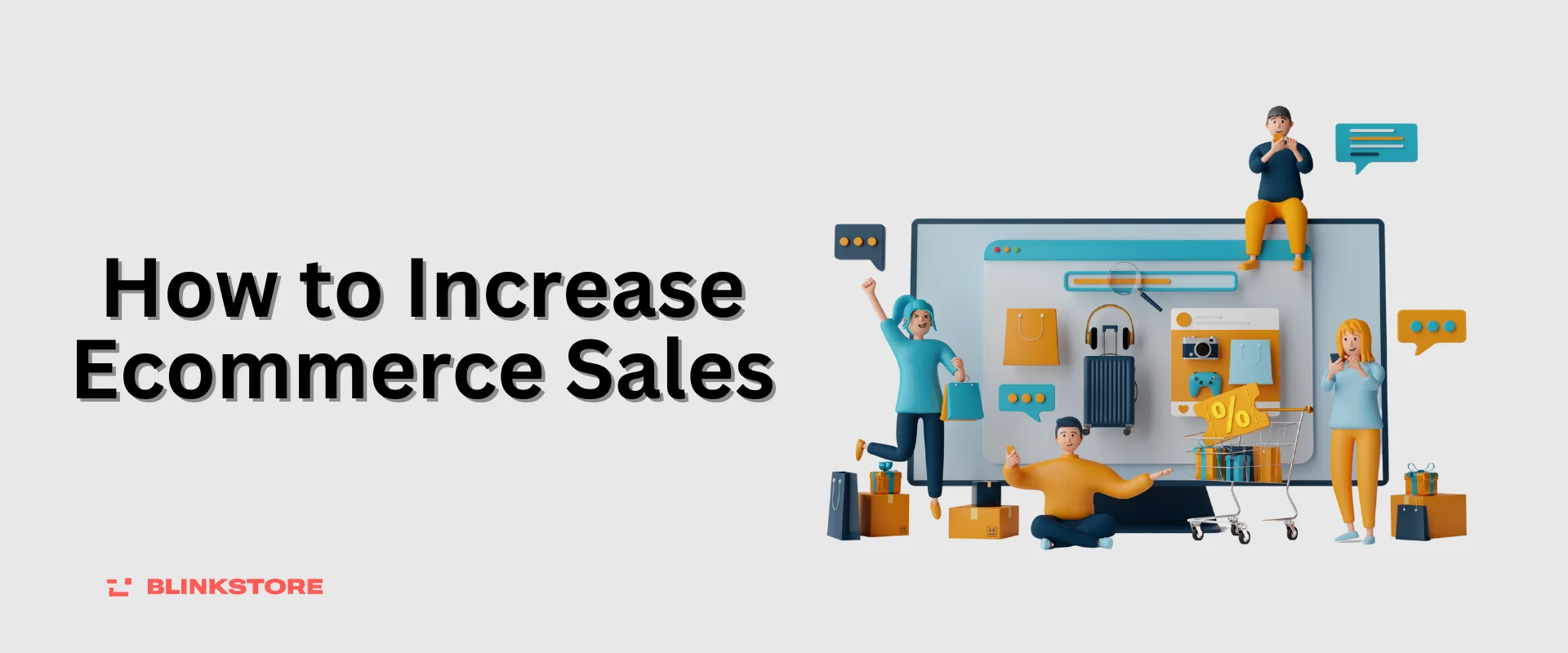You’ve put everything into making your e-commerce store. You’ve handpicked trending products, crafted a website design, and even invested in some marketing tactics. But despite all your efforts, the sales just aren’t rolling in like you’d hoped. Sound familiar?
Starting an e-commerce venture isn’t a breeze, but platforms like Blinkstore have simplified online store setups. The real hurdle? Boosting sales.
Standing out in today’s crowded market isn’t easy, but there are proven ways to increase e-commerce sales and expand your reach.
Online shopping is booming—56.6% of consumers prefer it over in-store visits. In this blog, discover practical tips on how to increase ecommerce sales and capture more customers. Let’s dive in!
Table of Contents
Why Should You Increase Ecommerce Sales Conversion?
“Conversion rate optimization is the holy grail of e-commerce.”
– Avinash Kaushik, Digital Marketer at Google
Increasing e-commerce sales conversion is really important to start your ecommerce business. It means turning more of your website visitors into customers.
By doing this, you can make more sales without needing to bring in extra visitors. Even a small improvement in conversion rate, like just 1%, can lead to a big increase in profits.
Studies show that focusing on making these improvements, is known as conversion rate optimization (CRO). This can be very effective.
By working on conversion rate optimization, businesses can make better use of their website traffic, increase sales, and get more out of their marketing spending. This approach is key for staying competitive and succeeding in online business.
Therefore, ecommerce strategy helps you market your products to attract potential buyers and build trust. It also guides your marketing and sales teams, making their work more efficient and reducing costs. Here we will guide you on how to increase ecommerce sales with practical ways.
26 Best Ways to Increase Ecommerce Sales
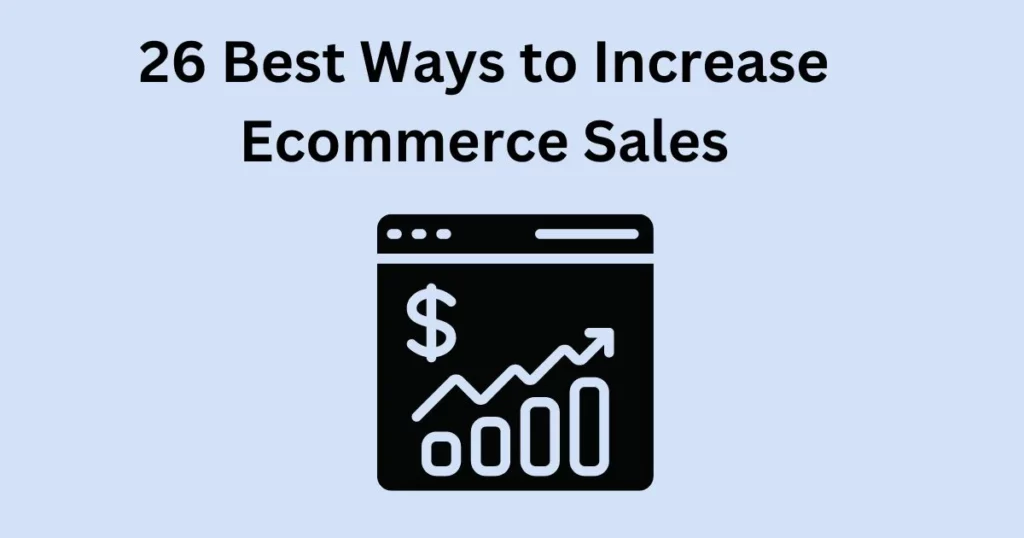
Let’s get into the topic and understand how to increase ecommerce sales for your business:
1. Know Your Audience Well
“Nobody cares about your products or services. They care about their own problems and aspirations.”
– Simon Sinek, Author & Motivational Speaker
Here’s how to Know your audience effectively:
- Conduct Market Research: Dive deep into your target demographics, gathering data on age, gender, location, interests, and specific shopping behaviors. For example, if you’re selling athletic wear, understanding that your audience is predominantly young adults interested in fitness will shape your content and messaging.
- Create Detailed Buyer Personas: Develop vivid profiles that embody your ideal customers based on research insights. For instance, imagine “Fitness Enthusiast Emily,” a 25-year-old yoga instructor passionate about sustainable activewear. This persona helps personalize your marketing efforts.
- Utilize Advanced Analytics Tools: Leverage powerful analytics platforms like Google Analytics. To gain real-time insights into website traffic, user behavior, and conversion metrics. Identify which marketing channels drive the most sales and optimize accordingly.
Stat: According to a McKinsey & Company report, personalized marketing can generate up to 80% more revenue.
2. Plan a Strategic Content Marketing Approach
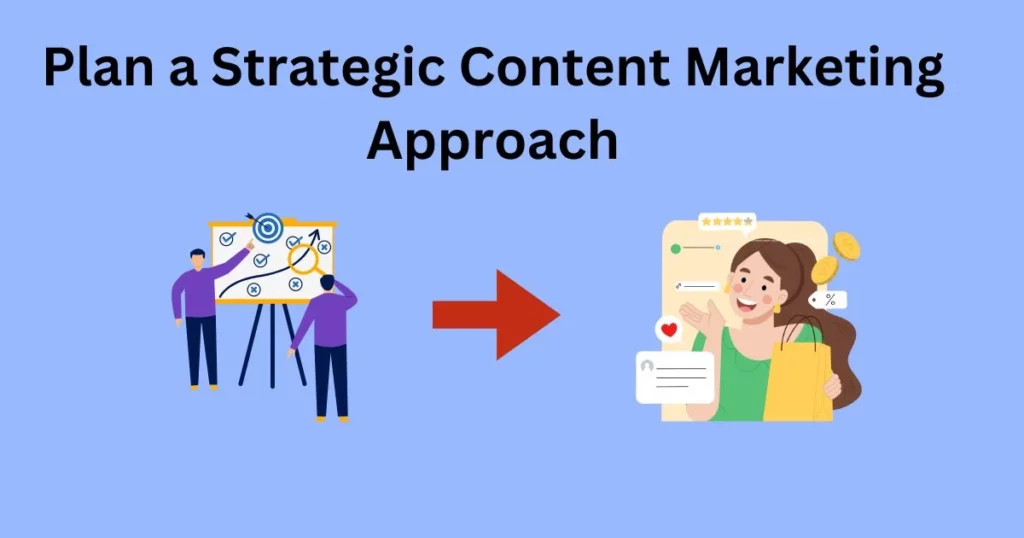
Content marketing generates about 3x the leads compared to traditional marketing, but costs 62% less Content Marketing Institute.
- Define Clear Goals: Establish specific objectives for your content, such as increasing brand awareness, generating leads, or driving direct sales. Setting measurable goals ensures alignment with broader business objectives.
- Diversify Content Formats: Identify content types that resonate best with your audience. Such as blog posts, videos, infographics, or user-generated content. Tailor content formats to match audience preferences and consumption habits.
- Develop a Consistent Content Calendar: Map out a schedule for content creation and publication to maintain a steady flow of relevant and timely content. This ensures consistency and keeps your brand top-of-mind for your audience.
- Pro Tip: Use content planning tools like CoSchedule or Trello to organize and manage your content calendar efficiently.
3. Test and Optimize Messaging for Maximum Impact
Experimenting with different messages allows you to refine your approach and boost engagement:
- Implement A/B Testing: A/B testing can lead to a 30% increase in conversions Crazy Egg. Test variations of headlines, calls to action (CTAs), and promotional offers to identify high-performing combinations. For example, compare two versions of a product description to determine which drives more conversions.
- Monitor Key Engagement Metrics: Track critical metrics like click-through rates, conversion rates, and bounce rates. So measure the effectiveness of your messaging strategies. Use this data to optimize and iterate on your content approach.
- Segment Your Audience for Personalization: Divide your audience into distinct segments based on demographics, behaviors, or purchase history. Deliver tailored messages and offers that resonate with each segment’s specific needs and preferences.
- Pro Tip: Leverage marketing automation tools like HubSpot or Mailchimp to streamline A/B testing and audience segmentation processes, enabling data-driven decision-making.
4. Reach Customers at Every Buying Stage

“The aim of marketing is to know and understand the customer so well the product or service fits him and sells itself.”
– Peter Drucker, Management Consultant
Nurturing leads through email marketing can increase sales by up to 20% Email Monks.
- Awareness Stage: Attract attention with engaging blog posts, compelling social media content, and targeted ads that introduce your brand and products. For example, a cosmetic brand could create blog posts on skincare tips and share visually appealing product images on Instagram.
- Consideration Stage: Showcase product benefits, customer testimonials, and comparison guides to assist shoppers in evaluating options and building trust. For instance, an electronics retailer could highlight the unique features of a new smartphone model alongside positive user reviews.
- Decision Stage: Encourage purchase decisions by offering enticing incentives like limited-time promotions, free shipping, or discounts. Implement retargeting campaigns to re-engage potential customers who have shown interest but have not yet completed a purchase.
- Pro Tip: Use data analytics to identify common drop-off points in the customer journey and optimize marketing touchpoints accordingly.
5. Customize Your Marketing Messages
“The key is not to make the message about you, it’s about them.”
– Simon Sinek, Author & Motivational Speaker
Personalized messaging enhances engagement and conversion rates:
- Utilize Dynamic Content: Display personalized product recommendations based on browsing behavior or past purchases to enhance relevance and drive repeat sales. For instance, an online bookstore could suggest similar titles based on a customer’s recent purchases.
- Segment Your Audience: Divide your customer base into segments based on demographics, behaviors, or purchase history to deliver tailored promotions and content. For example, a fashion retailer might target different age groups with specific fashion trends or promotions.
- Implement Email Personalization: Address customers by name and send targeted emails featuring personalized product recommendations or exclusive offers based on their preferences.
- Pro Tip: Leverage automation tools like Mailchimp or Klaviyo to streamline personalized messaging and scale your efforts efficiently.
6. Focus on Providing Excellent Customer Service
“There is only one boss. The customer. And he can fire everybody in the company from the chairman on down, by simply spending his money somewhere else.”
– Sam Walton, Founder of Walmart
Exceptional service builds customer loyalty and advocacy:
- Offer Multi-Channel Support: Provide responsive live chat, email, and phone support to assist customers quickly and conveniently across multiple platforms.
- Resolve Issues Promptly: Respond promptly to inquiries, address concerns, and process returns or refunds efficiently to build trust and satisfaction.
- Solicit Customer Feedback: Regularly seek feedback through surveys or reviews to identify areas for improvement and demonstrate a commitment to customer satisfaction.
- Implement a Customer Loyalty Program: Reward repeat purchases with exclusive perks or discounts to encourage ongoing engagement and positive word-of-mouth referrals.
- Pro Tip: Use customer service metrics like Net Promoter Score (NPS) to measure satisfaction levels and identify opportunities for service enhancement.
7. Encourage Customers to Come Back
The probability of selling to an existing customer is 60-70%, while the probability of selling to a new customer is 5-20% MarketingSherpa. To foster customer loyalty and retention, implement these strategies:
- Customer Engagement Campaigns: Launch email campaigns with personalized offers or incentives for returning customers, such as loyalty discounts or exclusive access to new products.
- Create a Seamless Checkout Experience: Simplify the purchasing process by enabling guest checkout, saving customer preferences, and offering quick reorder options.
- Implement a Rewards Program: Develop a tiered loyalty program that rewards repeat purchases with points, discounts, or special perks.
- Pro Tip: Use customer purchase data to personalize recommendations and offers, increasing the likelihood of repeat purchases.
8. Share Customer Reviews and Stories
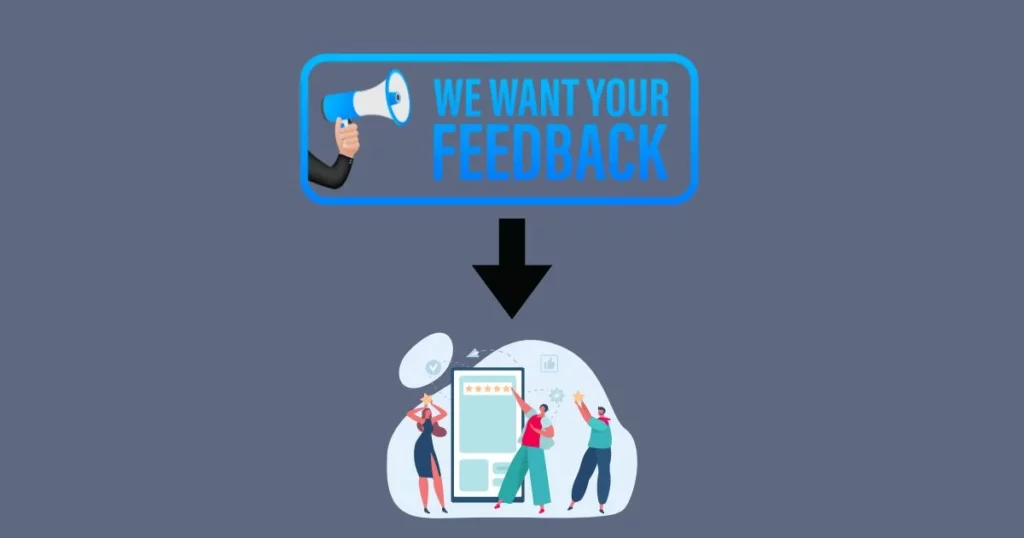
“A satisfied customer is the best business strategy of all.”
– Michael LeBoeuf, Business Author
- Feature Customer Testimonials: Showcase positive reviews and testimonials prominently on product pages to reinforce confidence in your brand.
- User-Generated Content: Encourage customers to share their experiences on social media using branded hashtags. Repost user-generated content to highlight authentic interactions with your products.
- Pro Tip: Utilize review platforms like Trustpilot or Yotpo to collect and display customer feedback effectively.
9. Offer Related Products and Upgrades
Upselling and cross-selling have the potential to raise average order value.
- Bundle Complementary Items: Create product bundles or kits that offer additional value when purchased together.
- Recommend Upgrades: Suggest premium or upgraded versions of products based on customer preferences or previous purchases.
- Pro Tip: Use data analytics to identify purchase patterns and tailor recommendations for relevant cross-selling opportunities.
10. Highlight Your Best-Selling Items
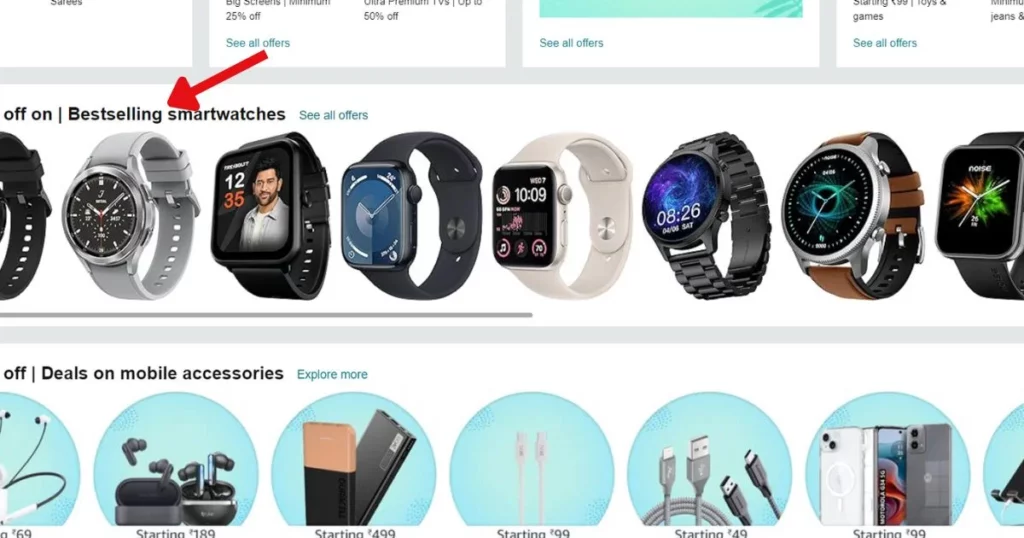
Social proof can increase conversions by up to 2.35% Social Proof. Promote top-performing products to drive sales:
- Featured Product Sections: Showcase best-selling items prominently on your homepage or category pages to capture attention.
- Limited-Time Offers: Create urgency by offering special discounts or promotions on popular products.
- Pro Tip: Monitor inventory levels and adjust promotions to prioritize high-demand items.
11. Use Videos to Showcase Popular Products
Including a product video on a landing page can increase conversions by up to 80% WordStream. Harness the persuasive power of video to showcase your top-selling items:
- Product Demonstrations: Create captivating videos showcasing product features, benefits, and real-world use cases. For example, demonstrate how a smart kitchen gadget simplifies meal preparation.
- Customer Testimonials: Produce video testimonials from satisfied customers discussing their experiences with your products. Authentic reviews build trust and credibility.
- Pro Tip: Leverage video platforms like TikTok or Instagram Reels for creative and engaging product showcases that resonate with a broader audience.
12. Learn How to Increase Ecommerce sales with Instagram
Instagram boasts an 8.8% average engagement rate, compared to 1.78% for Facebook Social Media Today. Maximize Instagram’s visual appeal to expand your brand’s reach:
- Compelling Content Creation: Share high-quality photos and videos of your products in real-life settings to inspire and attract potential customers.
- Utilize Stories and Reels: Leverage Instagram Stories and Reels to unveil new product launches, exclusive promotions, and user-generated content to foster community engagement.
- Pro Tip: Collaborate with niche influencers to leverage their audience and increase brand visibility among targeted demographics.
13. Make Your Online Store Mobile-Friendly
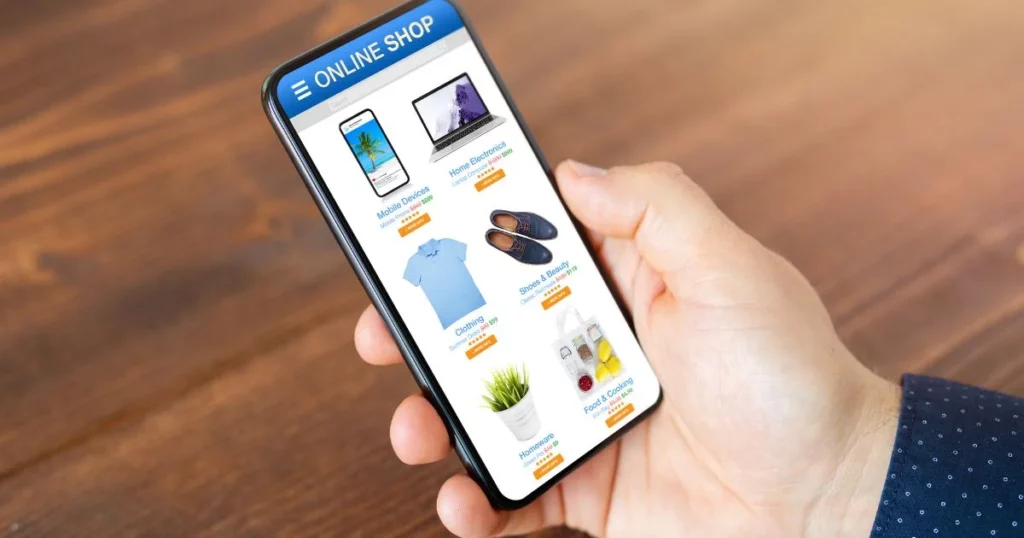
Optimize your e-commerce website for seamless mobile experiences:
- Responsive Design: Ensure your website layout and content adapt flawlessly to mobile screens, offering intuitive navigation and user-friendly interfaces.
- Fast Loading Times: Optimize images, videos, and code to accelerate page loading speeds, reducing bounce rates and improving user satisfaction.
- Pro Tip: Implement one-click mobile checkout options and offer mobile-exclusive promotions to drive conversions.
14. Improve Your Website’s Visibility with SEO
Organic traffic (SEO) can generate up to 20% more traffic compared to paid advertising Search Engine Journal. Enhance organic traffic and search engine rankings through strategic SEO practices:
- Keyword Optimization: Conduct thorough keyword research to integrate relevant keywords into product descriptions, meta tags, and blog content to improve search engine visibility.
- Content Creation: Develop comprehensive, value-driven content such as buying guides, tutorials, and industry insights to establish authority and attract organic traffic.
- Pro Tip: Utilize Google Search Console to monitor performance metrics and identify opportunities for SEO optimization.
15. Create an Engaging “About” Page
84% of customers say a company’s “About Us” page is important in deciding whether or not to trust the business Demand Metric. Craft a compelling brand narrative to connect with your audience:
- Storytelling: Share the story behind your brand, highlighting your mission, values, and commitment to customer satisfaction.
- Team Introduction: Humanize your brand by introducing key team members and their roles, fostering transparency, and building rapport.
- Pro Tip: Incorporate interactive elements like videos or infographics to make your About page visually engaging and memorable.
16. Build Trust by Showing How Your Products are Used
Demonstrate product value and authenticity to instill confidence in potential customers:
- Create How-To Guides: Develop comprehensive tutorials or guides showcasing various ways to use your products effectively.
- User-Generated Content: Invite clients to upload pictures or videos of themselves utilizing your merchandise. Share this authentic content on your website and social media to highlight real-life applications and foster community engagement.
- Pro Tip: Incorporate customer testimonials alongside usage examples to reinforce product benefits and build trust.
17. Reward Customers for Joining Your Newsletter

“Give them something of value, and they’ll keep coming back for more.”
– Brian Clark, Founder of Copyblogger
Incentivize newsletter subscriptions to cultivate a loyal customer base:
- Offer Exclusive Discounts: Provide special promotions or discounts to subscribers as a token of appreciation for joining your newsletter. Highlight exclusive offers that are only accessible to newsletter subscribers.
- VIP Access: Grant early access to new product launches, limited-edition releases, or exclusive content to newsletter subscribers to make them feel valued and privileged.
- Pro Tip: Implement a points-based rewards system where customers earn redeemable points for newsletter sign-ups and other engagement activities. This encourages ongoing interaction and fosters brand loyalty over time.
18. Use Customer Data to Make Smart Decisions
“In today’s business world, those who learn to harness the power of data will be in the driver’s seat.”
– Peter Drucker, Management Consultant
Businesses that use data-driven marketing see a 5-15% increase in sales productivity Marketo. Harness the power of data analytics to drive informed business decisions:
- Segmentation: Divide your customer base into segments based on demographics, behaviors, and purchase history to deliver personalized experiences. Customize product recommendations and marketing campaigns for particular customer groups.
- Behavioral Analysis: Analyze customer interactions and shopping patterns to anticipate needs and optimize marketing strategies. Use insights to refine product offerings, pricing strategies, and promotional activities.
- Pro Tip: Implement machine learning algorithms to predict customer preferences and tailor offerings accordingly. Leverage tools like Google Analytics and customer relationship management (CRM) systems to automate data analysis and decision-making processes.
19. Offer Live Chat for Immediate Support
“Customer service shouldn’t be a department. It should be the entire company.”
– Tony Hsieh, Zappos Founder
Provide real-time assistance to customers during their shopping journey:
- 24/7 Availability: Implement live chat functionality to address customer inquiries promptly, offering instant support and guidance.
- Personalized Assistance: Train customer support agents to provide tailored recommendations and solutions based on individual needs.
20. Simplify the Checkout Process
Cart abandonment rates can reach as high as 70% Baymard Institute. Minimize friction and maximize conversions with a user-friendly checkout experience:
- One-Click Checkout: Enable guest checkout and allow customers to save payment information for quick, hassle-free purchases. For instance, “Complete your purchase with just one click by saving your details securely for future orders.”
- Clear Navigation: Ensure a seamless flow from cart to checkout with intuitive design and minimal form fields.
21. Provide Flexible Delivery Options
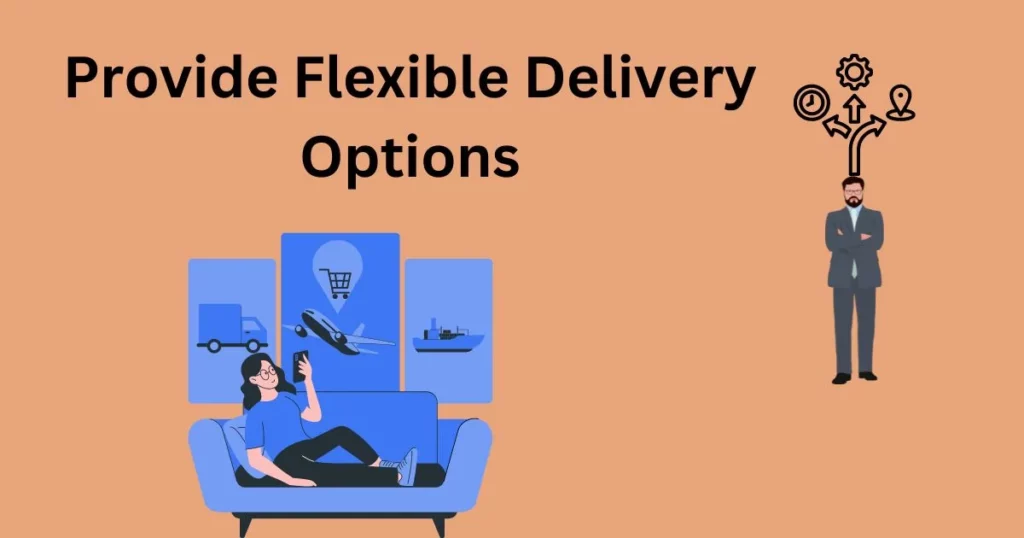
Offering free shipping can increase conversion rates by up to 35% Invesp. Empower customers with convenient delivery choices tailored to their needs:
- Express Shipping: Offer expedited delivery for urgent orders, appealing to time-sensitive customers.
- Click and Collect: Enable in-store pickup or alternative delivery locations for added flexibility and convenience.
22. Keep Customers Engaged by Removing Roadblocks
“Your most unhappy customers are your greatest source of learning.”
– Bill Gates, Co-founder of Microsoft
Eliminate obstacles that hinder customer satisfaction and retention:
- Optimize Site Performance: Regularly monitor and optimize website speed to minimize loading times and ensure seamless navigation.
- Clear Policies and FAQs: Provide transparent information on returns, refunds, and product details to address common concerns proactively.
23. Optimize Your Paid Advertising
“There’s a difference between throwing money at a problem and investing in a solution.”
– Harvey Mackay, Author & Motivational Speaker
Drive impactful results with targeted paid campaigns tailored to your audience:
- Audience Segmentation: Leverage data analytics to segment your audience based on demographics, interests, and online behaviors. For example, target young adults interested in fitness with ads for athletic wear.
- Ad Copy Testing: Experiment with different ad formats, messaging tones, and visuals to discover what resonates best with your target audience. Use A/B testing to refine your approach and maximize engagement.
24. Give Customers Choices for Payment

67% of online shoppers have abandoned their carts due to a lack of preferred payment options PYMNTS. Enhance checkout convenience and flexibility to cater to diverse customer preferences:
- Multiple Payment Gateways: Integrate a range of payment methods such as credit cards, and digital wallets (e.g., PayPal, Apple Pay) to accommodate different payment preferences.
- Subscription Services: Offer subscription-based payment models for recurring purchases, providing convenience and encouraging customer loyalty.
25. Expand Your Business to Reach Global Customers
Cross-border ecommerce sales are expected to reach $6.2 trillion by 2027 Statista. Capture international markets and expand your customer base with targeted strategies:
- Localized Content: Translate your website content, product descriptions, and marketing materials into multiple languages to cater to diverse cultural preferences and improve accessibility.
- International Shipping: Partner with reputable logistics providers to offer cost-effective and efficient shipping solutions worldwide.
26. Get Feedback from Customers After Purchase
“Listen to your customers. They are telling you what they need and want.”
– Philip Kotler, Marketing Professor
84% of customers say that a company offering an easy way to provide feedback is important Zendesk. Harness valuable insights and nurture customer relationships through post-purchase interactions:
- Feedback Surveys: Solicit feedback through follow-up emails or messages to gather insights on the overall shopping experience, product quality, and customer service.
- Review Incentives: Showcase customer reviews prominently on your website to build trust and credibility.
What are the Main Factors That Affect Ecommerce Sales?
There are several factors influencing ecommerce business. Let’s discuss them:
Pricing Strategy
Pricing is a critical factor influencing purchasing decisions. Competitive pricing, discounts, promotions, and transparent pricing policies can help attract customers and drive sales.
Shipping and Delivery
Fast and reliable shipping options, including free shipping or affordable shipping rates, can positively impact sales. Customers appreciate timely delivery and may abandon carts if shipping costs are perceived as too high.
Customer Reviews and Testimonials
Positive reviews and testimonials from satisfied customers can build credibility and encourage new buyers to make purchases. Encouraging customer feedback and addressing any concerns promptly can boost sales.
Your Store Traffic
The volume and quality of visitors to an online store directly influence potential sales. Increased targeted traffic often correlates with higher conversion rates.
Conversion Rate
This refers to the percentage of website visitors who make a purchase. A higher conversion rate indicates more effective marketing and website optimization, leading to increased sales.
Average Lifespan Value of a Customer
Understanding how much revenue an average customer generates over their lifetime with a business is essential. Increasing customer loyalty and encouraging repeat purchases can boost the overall lifetime value and contribute to higher ecommerce sales.
Conclusion
In summary, achieving success in e-commerce sales in 2024 demands a strategic approach blending data-driven insights with customer-focused practices. Remember to understand your audience, optimize user experiences, and adapt based on feedback and analytics. With dedication and adaptability, you can navigate e-commerce challenges and drive sustainable growth in the digital marketplace.
So why not start your free ecommerce store with Blinkstore? Blinkstore stands as one of the best ecommerce platform in India to launch your business!
FAQs on How to Increase Ecommerce Sales
Here are some frequently asked questions about How to Increase Ecommerce Sales.
How Can Ecommerce Increase Revenue?
To increase ecommerce revenue, focus on optimizing your website for conversions, implementing effective marketing strategies, expanding your product offerings, and providing exceptional customer service.
What is the Sales Strategy of Ecommerce?
Ecommerce sales strategies include using data-driven insights, implementing targeted marketing campaigns, offering personalized shopping experiences, optimizing the checkout process, and leveraging upselling and cross-selling techniques.
How Do You Optimize Ecommerce Sales?
Optimize ecommerce sales by improving website speed and user experience, optimizing product pages with high-quality images. Give detailed descriptions, implement SEO best practices, utilize email marketing and retargeting, and analyze customer behavior to make data-driven decisions.
How Do I Get More Customers for My Ecommerce?
Focus on creating valuable content, utilizing social media marketing, offering incentives such as discounts or free shipping, collaborating with influencers, and optimizing your website for search engines.
How to Grow Sales in Ecommerce?
Grow ecommerce sales by diversifying product offerings, improving customer service and support, investing in digital advertising, analyzing and optimizing conversion funnels, and nurturing customer relationships through email marketing and loyalty programs.
How to Grow Your Ecommerce Store?
Build brand awareness, optimize for mobile devices, enhance the customer shopping experience, expand into new markets or sales channels, and continuously refine your ecommerce strategy based on performance metrics and customer feedback.
Related Resources:
- The Best Ecommerce Website Builders in 2024
- E-commerce vs Retail: What Makes the Difference (2024)
- How To Start an Ecommerce Business In India: 2024 Best Guide
- 30 Most Profitable eCommerce Business Ideas in 2024
- 23 Best E-commerce Frameworks in 2024 (Detailed Comparison)
- Types of eCommerce Websites You Should Know in 2024
